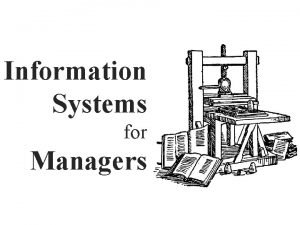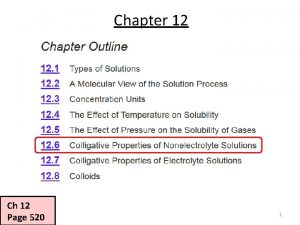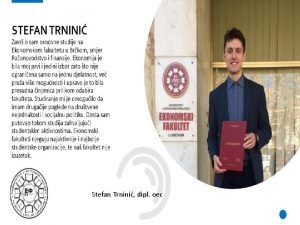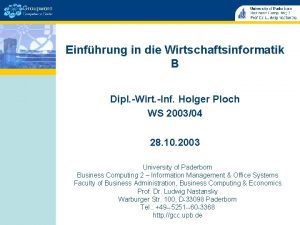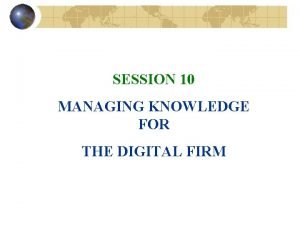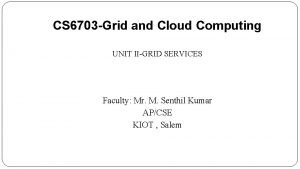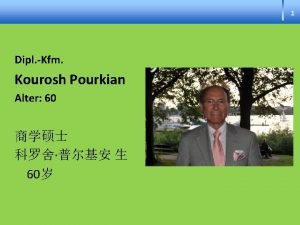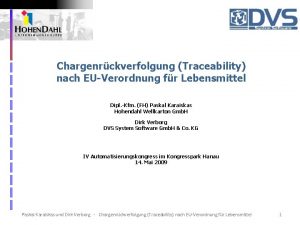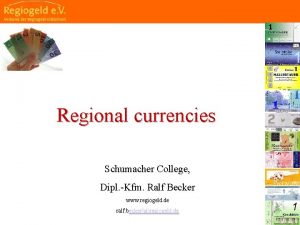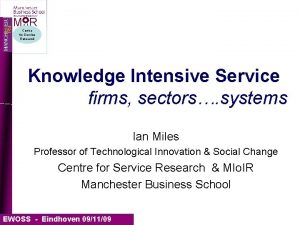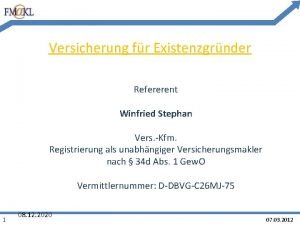TaskTechnologyFit in Knowledge Intensive Service Environments Dipl Kfm




![Activity Structure Advisor Project Manager Knowledge Worker (following [Netzer 2000, S. 87]) University of Activity Structure Advisor Project Manager Knowledge Worker (following [Netzer 2000, S. 87]) University of](https://slidetodoc.com/presentation_image_h2/50499cc8c4d2516595c417ddfb8dffd1/image-5.jpg)



- Slides: 8

Task-Technology-Fit in Knowledge Intensive Service Environments Dipl. Kfm. Lars Kemper Groupware Competence Center WINFO Forschungskolloquium Erwitte, June 29 th, 2007 University of Paderborn Dept. Business Information Systems Prof. Dr. Ludwig Nastansky 1

Knowledge Intensive Services KIS explained: high low Customer Relation Mass Services Example: Call Center Customer Self Service Knowledge Intensive Services Example: Consulting Market Research Service Factory Service Shop Example: Cash Point Fast Food-Restaurant Example: IT-Outsourcing Insurance low high Diversity Attributes of Service Offerings intangible, individual interactive, collaborative knowledge based, knowledge intensive innovative, non-routine (following [Bullinger 2001, S. 158]) University of Paderborn Dept. Business Information Systems Prof. Dr. Ludwig Nastansky 2

Organizational Aspects Knowledge Processes Project Processes 2 - or more dimensional structure (e. g. function, branch, technology) increasing virtuality increasing self-organization knowledge paradox Standard and Support Processes inverse relation of dependence between employer and employee Customer is also co-producer (“prosumer”) factor of profit and cost substitute for leadership quality and marketing resource outstanding position of knowledge worker in value chain (following [Schnauffer et al. 2004, S. 18; Porter 2000, S. 66, Lehmann 1998, Maister 1983]) University of Paderborn Dept. Business Information Systems Prof. Dr. Ludwig Nastansky 3

Task-Technology-Fit Approach Optimizing Effectiveness and Efficiency of Knowledge Workers in Office Environments System Employee Sy r e q u st e m i re m ent s ls Skil Task. Technology. Fit Process. Requirements Process (following [Goodhue 1995]) University of Paderborn Dept. Business Information Systems Prof. Dr. Ludwig Nastansky 4
![Activity Structure Advisor Project Manager Knowledge Worker following Netzer 2000 S 87 University of Activity Structure Advisor Project Manager Knowledge Worker (following [Netzer 2000, S. 87]) University of](https://slidetodoc.com/presentation_image_h2/50499cc8c4d2516595c417ddfb8dffd1/image-5.jpg)
Activity Structure Advisor Project Manager Knowledge Worker (following [Netzer 2000, S. 87]) University of Paderborn Dept. Business Information Systems Prof. Dr. Ludwig Nastansky 5

Analysis Method Example Questions: Collaboration Ø low Routine high Ø low Müssen Sie sich mit Kollegen […] abstimmen? Wie oft stehen Sie vollkommen neuartigen Aufgabenstellungen gegenüber? Measurability high Options to Change low Ø low Sind Ihre Arbeitsergebnisse in Einheiten (z. B. Stück, Fallzahlen) messbar? Ø high = single values Wie oft bestimmen Sie in Ihrem Arbeitsalltag die Reihenfolge der Aufgabenbearbeitung selbst? Folie 6 Advisor - Project Manager - Knowledge Worker University of Paderborn Dept. Business Information Systems Prof. Dr. Ludwig Nastansky 6

motivators low medium high quality of execution low medium high satisfaction about way of execution employee‘s view de-motivators demotivators low strength Importance of Activity medium high weakness low importance of activity medium high Analysis Method Advice Training weakness Optimum Feedback strength employer‘s view = activity class Efficiency Criteria: • Pull-Model instead of Push-Model • Information Sharing • paperless work without changing media • avoiding data traffic and data volume University of Paderborn Dept. Business Information Systems Prof. Dr. Ludwig Nastansky 7

Research Task How to measure effectiveness and efficiency of knowledge workers in office environments? University of Paderborn Dept. Business Information Systems Prof. Dr. Ludwig Nastansky 8
